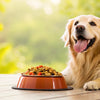What is a Good Dog Food for Weight Loss? A Comprehensive Guide for Pet Owners
- Houndsy
Table of Contents
- Introduction
- Understanding Canine Obesity
- Key Nutritional Components for Weight Loss
- Top Dog Food Options for Weight Loss
- Transitioning to Weight Loss Food
- The Role of Exercise in Weight Loss
- Maintaining a Healthy Weight
- Conclusion
- FAQ
Introduction
Did you know that approximately 56% of dogs in the U.S. are classified as overweight or obese? This startling statistic underscores a growing concern in the pet community: maintaining a healthy weight for our furry companions. As pet owners, we often find ourselves wondering, what is a good dog food for weight loss? The answer is crucial because excess weight can lead to a host of health issues, including diabetes, arthritis, and heart disease.
In this blog post, we will explore the important elements of dog food tailored for weight loss. We’ll provide insights into the nutritional components that promote healthy weight management, the role of exercise, and practical tips for implementing a weight loss plan for your dog. By the end of this article, you’ll have a comprehensive understanding of how to choose the right dog food to help your furry friend shed those extra pounds safely and effectively.
As we dive into this topic, we invite you to reflect on your dog’s current diet and feeding routine. Are there areas where you could improve? Let’s take a closer look at how we can support our pets in achieving their ideal weight.
Understanding Canine Obesity
The Impact of Obesity on Health
Before we discuss food options, it's essential to understand what obesity means for our dogs. Just like in humans, excess weight can lead to numerous health complications:
- Joint Problems: Extra weight places undue stress on joints, leading to conditions like arthritis.
- Heart Disease: Overweight dogs are at a higher risk for heart disease, which can dramatically affect their quality of life.
- Diabetes: Obesity is a significant risk factor for developing diabetes in dogs, which can lead to serious health consequences.
- Reduced Lifespan: Studies have shown that dogs maintained at an ideal weight can live up to two years longer than their overweight counterparts.
Recognizing Obesity in Dogs
As dog parents, it’s our responsibility to monitor our dogs' weight. To assess whether your dog is overweight, consider the following:
- Body Condition Score (BCS): The BCS scale ranges from 1 (emaciated) to 9 (obese). A score of 4 to 5 is typically ideal.
- Rib Check: You should be able to feel your dog's ribs without excessive pressure. If you cannot, your dog may be overweight.
- Waist Measurement: When looking at your dog from the top, there should be a noticeable waist between the ribs and hips.
Consulting Your Veterinarian
Before embarking on a weight loss journey for your dog, we strongly recommend consulting with your veterinarian. They can assess your dog's overall health and help you determine an appropriate weight loss plan tailored to your dog's individual needs.
Key Nutritional Components for Weight Loss
When considering what is a good dog food for weight loss, it’s essential to focus on specific nutritional components that promote healthy weight management. Below are the key factors to consider when selecting a weight loss dog food:
1. High Fiber Content
Fiber plays a critical role in promoting satiety, helping your dog feel full without consuming excess calories. Foods rich in fiber can aid digestion and regulate bowel movements. Look for dog foods that contain highly digestible fiber sources, such as:
- Pumpkin
- Sweet potatoes
- Brown rice
- Oats
2. Low-Calorie Formulas
To help your dog lose weight, select a food that offers fewer calories per cup. Lower-calorie foods allow you to maintain a healthy portion size while encouraging weight loss. A good guideline is to choose foods that contain 30% fewer calories than standard dog food.
3. Lean Protein Sources
High-quality lean proteins, such as chicken, turkey, or fish, are vital for maintaining muscle mass during weight loss. Protein aids in fat burning and helps keep your dog satisfied. Aim for foods that provide at least 20-30% protein content.
4. Quality Ingredients
Always check labels for quality indicators. Look for dog food that:
- Is formulated by veterinary experts
- Meets standards set by the Association of American Feed Control Officials (AAFCO)
- Underwent feeding trials to ensure safety and efficacy
5. No Fillers or Unnecessary Additives
Avoid dog foods that contain fillers, artificial preservatives, or excessive carbohydrates. Ingredients like corn, wheat, and soy are often used as fillers and can contribute to weight gain.
Top Dog Food Options for Weight Loss
With a clearer understanding of what to look for, let’s explore some of the best dog foods for weight loss. Each option provides a balance of essential nutrients that promote healthy weight management.
1. Houndsy Kibble Dispenser
We believe that feeding should be as enjoyable and aesthetically pleasing as it is functional. Our Houndsy Kibble Dispenser is designed to help pet owners portion their dog’s food accurately while maintaining a beautiful aesthetic in their homes. With a large storage capacity of 25-30 lbs, our dispenser features an ergonomic crank at standing height to eliminate bending and a BPA-free liner to keep kibble fresh.
Order your Houndsy Kibble Dispenser today!
2. Wellness Core Weight Management
This canned dog food is formulated with fresh chicken and a blend of lean proteins, providing 50% protein while being low in fat. It's a great choice for dogs needing to lose weight while maintaining muscle mass.
3. Nutro Ultra Small Breed Weight Management
Designed specifically for small breeds, this dry dog food features high-quality chicken and offers a balanced 29% protein content. It is formulated to help small dogs lose weight while keeping them satisfied.
4. Merrick Grain-Free Texas Beef & Sweet Potato Recipe
Merrick’s grain-free option is made from real beef and sweet potatoes, providing a good source of protein and fiber. It contains 36% protein and is excellent for larger breeds managing their weight.
5. Blue Buffalo Life Protection Healthy Weight
This formula is crafted with whole grains and real meat, ensuring dogs receive high-quality nutrition while managing their weight. It includes 20% protein and is enriched with LifeSource Bits, a precise blend of nutrients.
6. Annamaet Lean
This dry dog food option is made with chicken meal and features 33% protein with a low-fat content. It's a great choice for overweight dogs needing a lean protein source.
Transitioning to Weight Loss Food
Switching your dog to a weight loss food requires a careful approach to avoid digestive upset. Here are some steps to consider:
- Gradual Transition: Mix 25% of the new food with 75% of the old food for the first few days. Gradually increase the new food until it is 100% over a week.
- Monitor Weight: Weigh your dog regularly to ensure they are losing weight at a safe rate, typically 1-2% of their body weight per week.
- Adjust Portions: Follow the feeding guidelines on the package and adjust based on your dog's unique needs.
The Role of Exercise in Weight Loss
While diet plays a crucial role in weight management, exercise is equally important. Aim for:
- Daily Walks: At least 30 minutes of walking can help burn calories and maintain muscle tone.
- Playtime: Engage in play with toys or other dogs to encourage physical activity.
- Training Sessions: Incorporate training into playtime to stimulate your dog mentally and physically.
Maintaining a Healthy Weight
Once your dog reaches their target weight, maintaining that weight is essential. Here are tips to keep your dog healthy:
- Regular Check-Ups: Schedule regular vet visits to monitor your dog’s weight and overall health.
- Ongoing Portion Control: Continue to measure food portions carefully, adjusting as needed.
- Mindful Treating: Limit treats to 10% of daily caloric intake and opt for healthy options like vegetables.
Conclusion
Understanding what is a good dog food for weight loss is essential for every pet owner committed to their dog's health. By focusing on high fiber, low-calorie formulas, lean proteins, and quality ingredients, we can help our furry friends shed excess weight safely. Additionally, incorporating regular exercise and maintaining a consistent feeding routine ensures long-term health and happiness.
As we reflect on our journey with our dogs, let’s remember that every small change contributes to their well-being. If you’re looking to simplify and elevate your dog feeding experience, consider our Houndsy Kibble Dispenser to make portion control effortless and stylish.
Explore our Houndsy Kibble Dispenser to enhance your pet's feeding routine today!
FAQ
What type of dog food should I choose for weight loss?
Select a dog food that is high in fiber, low in calories, and contains lean protein sources. Always check for quality ingredients and consult your veterinarian for recommendations tailored to your dog’s specific needs.
How can I safely transition my dog to weight loss food?
Gradually mix the new weight loss food with your dog's current food over a week, starting with 25% of the new food and increasing to 100%. Monitor their weight throughout the transition.
Is wet or dry dog food better for weight loss?
Both wet and dry foods can be effective for weight loss, but wet food may create a greater sensation of fullness due to its moisture content. Ultimately, it depends on your dog’s preference and dietary needs.
What role does exercise play in my dog's weight loss?
Exercise is essential for burning calories and maintaining muscle mass. Regular physical activity, such as daily walks and playtime, should be combined with a healthy diet for effective weight loss.
How often should I feed my dog weight loss food?
The feeding schedule typically depends on your dog's dietary needs, but it’s advisable to split their daily caloric intake into two or more meals. Consult your veterinarian for personalized recommendations.













